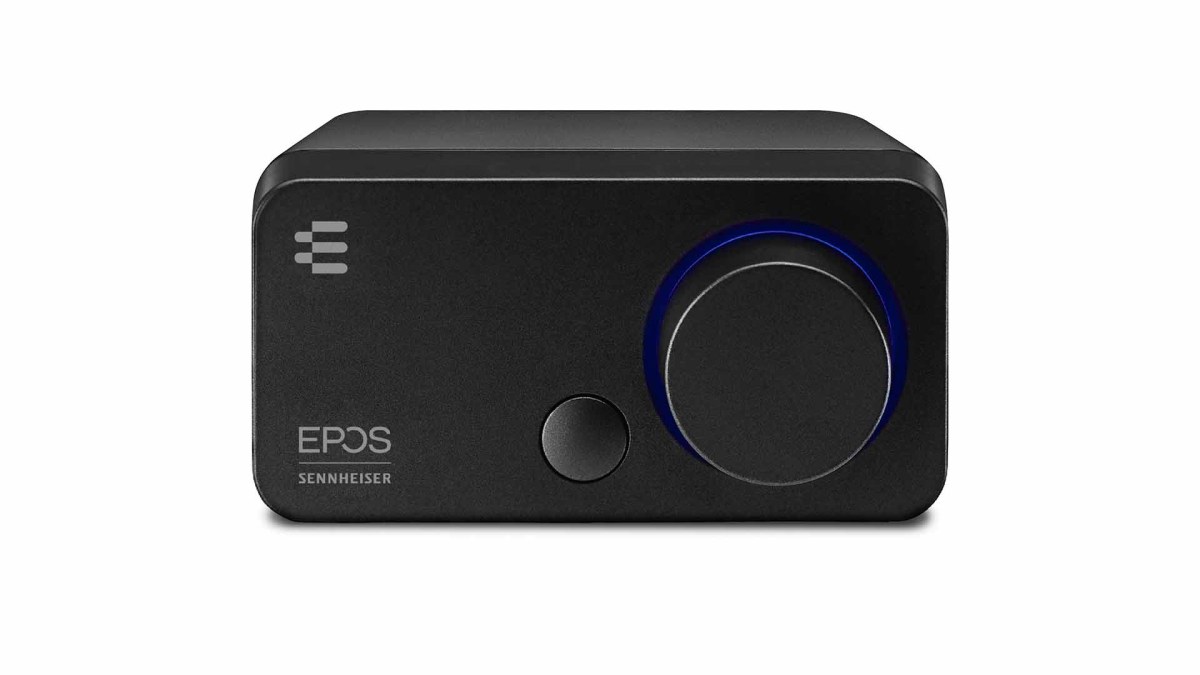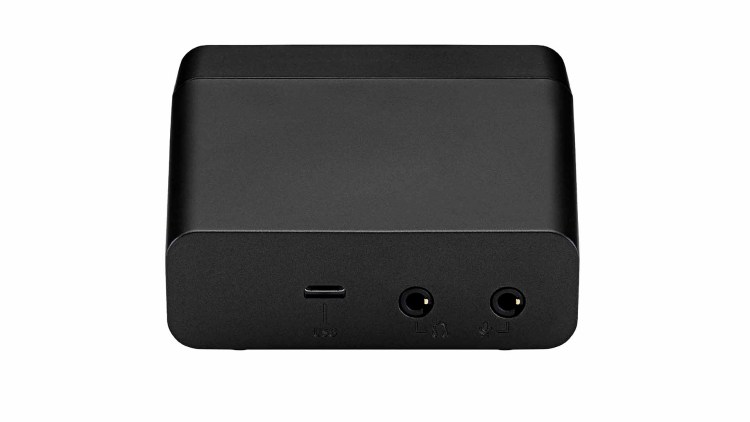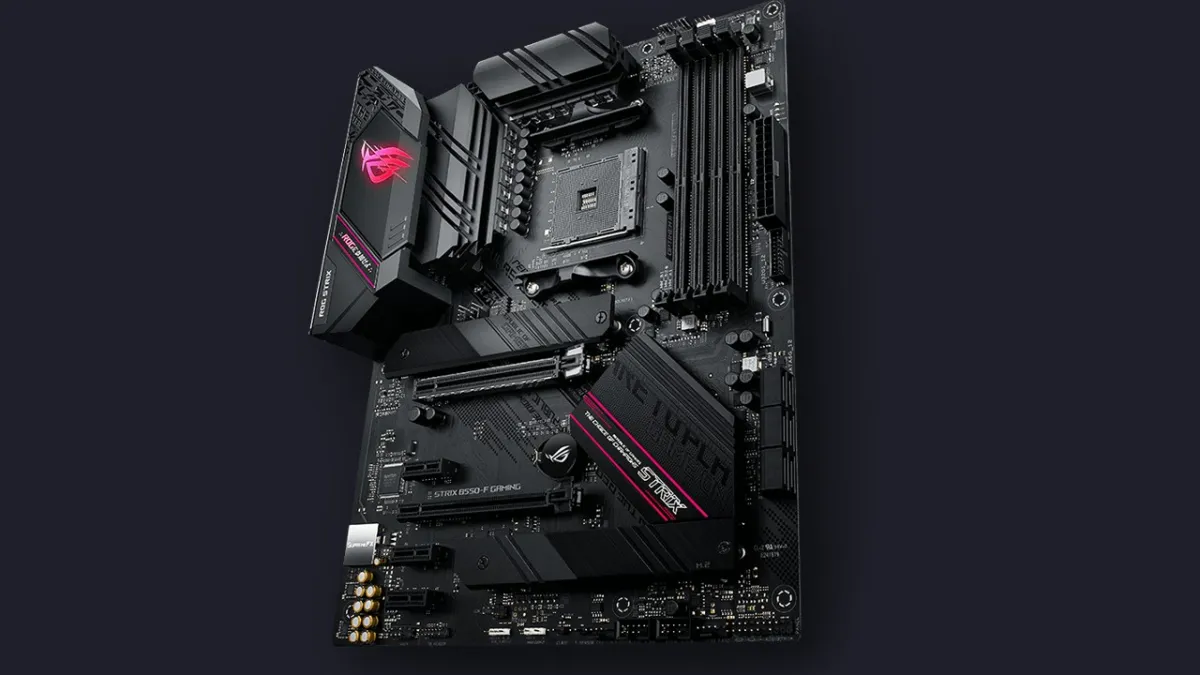Designed for high-end audio for gaming with Sennheiser co-branding, the EPOS GSX 300 External Sound Card is designed to deliver 24-bit, 96 kHz virtual 7.1 surround sound to ordinary stereo headphones. If all you’re looking for is a digital-to-analog converter (DAC) to use your existing 3.5mm stereo headphones for gaming on your computer, then the GSX 300 certainly does the job while adding some extra enhancements. However, the device can be a little too minimalistic, given the multitude of audio options available right now.
Connecting the EPOS GSX 300
The GSX 300 connects via a USB 2.0 port using an included cable and has two separate 3.5mm audio jacks for headphones and a microphone. Its compact design includes a LED illuminated volume knob and a smart button that cycles through the different sound profile presets. But even with this sparse design, some flaws are apparent right out of the box. The most obvious is that the 3.5mm audio jacks are located on the rear of the device instead of its front, which meant that the GSX 300 ended up sitting on my desk backwards. That’s not exactly a deal-breaker, but it seems like a silly oversight when a renowned brand such as Sennheiser is involved.
However, the issues didn’t stop there. My unit came with a spec sheet, safety documentation, and a strange little quick start guide that didn’t provide any actual guidance. Plugging in the GSX 300 using the included micro USB cable is simple enough, but you only get flat stereo sound from it without the EPOS Gaming Suite software. I had to visit the EPOS website to find the real guide with the software link, which is way more trouble than it should take to get this thing going.
With everything finally set up, I plugged in my Audio-Technica ATH-M50x headphones and loaded up the software. I wasn’t expecting a ton of bells and whistles from the application, but I didn’t think it would be quite so sparse either. With the inclusion of ‘flat’ sound, there are exactly four audio presets. The other stereo configuration enhances music quality. The 7.1 surround sound presets include ‘esports,’ which turns the treble and high end way up to gain an advantage in competitive games while ruining the rest of the game sounds. Lastly, there’s a movie mode for watching videos.
It’s probably obvious that out of the four presets, music and movie are the most impressive, and they do an excellent job of enriching audio. But it’s shocking that a DAC that is designed with gamers in mind doesn’t have a gaming preset apart from an esports configuration that is meant for competitive players who are more concerned with hearing footsteps than appreciating the music and sound artistry. The movie mode does an excellent job with the gaming audio, and you can create custom audio profiles, but it would have been nice to see a dedicated gaming preset to start with – especially if you don’t want to spend a lot of time fiddling around with the equalizer.
The front of the GSX 300’s small smart button can be configured to cycle through audio presets or switch between stereo and 7.1 surround sound modes. Also, the illuminated ring around the knob changes from blue to red to show whether it’s in stereo or surround mode – an effect that’s diminished by how I had to turn the device around. A small window pops up above the taskbar to indicate which profile is loaded, but it doesn’t always appear with certain games. So, you either need to quit out to be certain or blindly cycle through the presets in the hope that you’ve loaded the profile that you want. I suppose this is an unintentional benefit of having so few profiles.
Immersing into audio
As a gaming audio interface, the EPOS GSX 300 delivers a minimal set of features. For instance, the Creative Sound BlasterX G6 features built-in Dolby Digital decoding, 32-bit sound at 384 kHz, and various switches and buttons. It’s not too surprising that it provided a richer audio experience for me. It’s also significantly more expensive. So, I tested the GSX 300 alongside my computer’s integrated Realtek 3D audio and an old Focusrite Scarlett Solo USB DAC, which I enhanced with Windows Sonic spatial audio in Windows 10, while playing the opening scene from Hellblade: Senua’s Sacrifice.
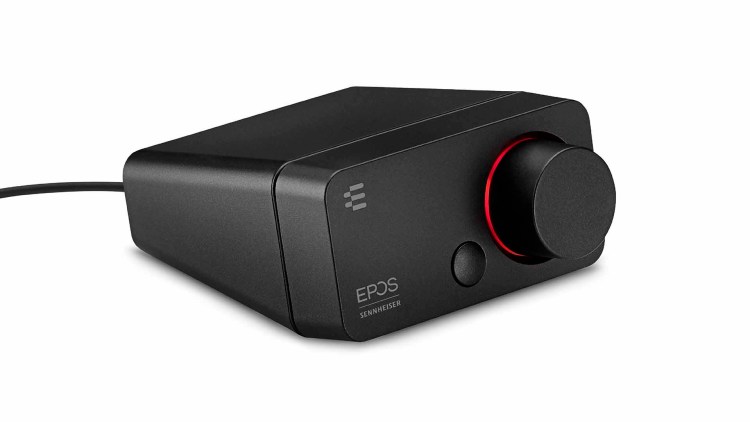
The red and blue LED ring around the volume knob lets you know whether you’re in stereo or 7.1 surround sound mode.
I was a bit surprised to find that my motherboard’s built-in audio has more robust software than EPOS. Not only does it allow me to have individual audio presets for just about every game and application I have installed, but there’s also an equalizer preset made specifically for Audio-Technica ATH-M50x headphones. In addition to the virtual surround sound options, I could indulge my inner audiophile by pushing the frequency settings to 32-bit, 192 kHz. Still, I feel that the GSX 300 provides a slightly deeper experience than my built-in audio, with Senua‘s whispering voices coming in more clearly. But the excellent quality from the built-in option is enough to make me question the GSX 300’s value while further highlighting its sparse software.
There’s also the unavoidable fact that the Realtek audio is integrated onto my motherboard and doesn’t require any additional purchases outside of pair of headphones or a speaker system. But I realize that the GSX 300 is designed for people who are either dissatisfied with their onboard audio or otherwise need a USB audio interface for clear sound through their stereo headphones.
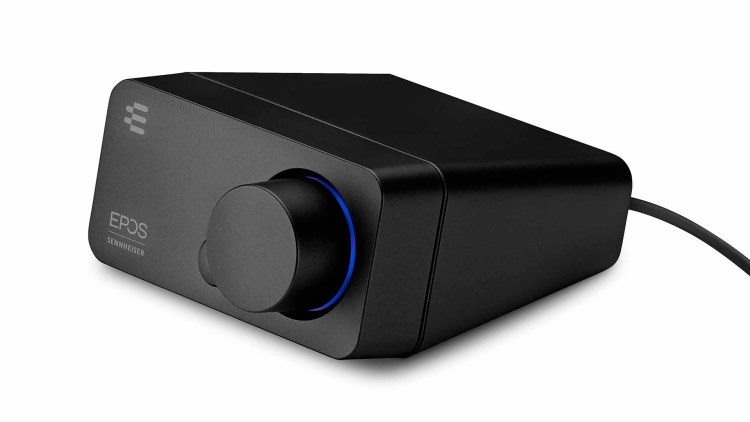
With its compact design, the EPOS GSX 300 External Sound Card fit nicely onto my desktop without adding too much clutter.
The Focusrite Scarlett Solo is a relatively straightforward DAC that’s made to support XLR microphones, instruments, and headphones with a 1/4-inch jack. It’s certainly not designed for gaming. Instead, it’s geared more toward music, and you need third-party equalizer software to adjust it, but it supports a 24-bit, 192 kHz audio and delivers excellent stereo sound. It can also be enhanced with Windows Sonic spatial audio, which is built into Windows 10.
Although the GSX 300 comes out ahead in many respects, I was still quite impressed with the quality of the Focusrite Scarlett Solo. I couldn’t adjust the audio settings to match different games and genres without equalizer software, and it would be a pain to switch between profiles if I could, but it was enough to bring the haunting sounds of Hellblade to life. Plus, the Scarlett’s built-in amplifier provided me with extra volume if I needed it.
Being heard
Where the GSX 300 surpasses the Scarlett is with the outgoing communications. With the EPOS software, you can enhance your voice quality, adjust the microphone gain, and set up noise cancellation. The Focusrite allows you to manually adjust the gain using a dedicated knob, but it can still pick up a ton of environmental noise depending on the microphone you’re using. Having these settings helps if your headset doesn’t have built-in noise cancellation or if you’re looking to add to its capabilities.
https://youtu.be/1eJYtNeP_Cg
On the other hand, peripherals such as the Turtle Beach Atlas Edge Audio Enhancer cost much less and allow generic headsets access to powerful audio software that leaves the EPOS utility in the dust. The trade-off is that you lose the audio knob, push-button profile switcher, and separate 3.5mm jacks. Still, the front panel controls might not be much of a sacrifice, considering how the GSX 300 spent most of its time turned around on my desk anyway.
The fact of the matter is, there are enough free and inexpensive audio options available to make the EPOS GSX 300 difficult to recommend unless you absolutely need a compact USB audio interface with a volume knob for your wired headset. Its software, which should be the centerpiece of this relatively straightforward device, is far too sparse and requires manual equalizer adjustments if you want to get the most out of it. Not to mention the poorly placed audio jacks and the rougher than expected installation process. Regardless, the GSX 300 delivers high-quality sound to ordinary stereo headphones. It’s far from being the perfect gaming-oriented USB audio interface, and it faces plenty of competition, but it gets the job done.

